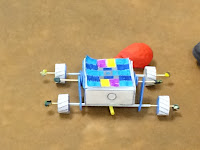It was interesting to start this with the ‘dumb robot’
lesson. I realized that for most of the
students, their only connection with robots was with cartoon characters that
could walk and talk and think. I had to give them a background on what a ‘dumb robot’ really was.
I found a video of a toothpick factory in action to help them understand what a robot may actually do. Never assume anything with a 5-year-old!
When we went back to the ‘dumb robot’ lesson, I they
continued to make assumptions that the robot knew which way they were pointing,
knew what ‘follow me’ meant, and knew what a square was. I even had to have a group really think about
the difference between ‘standing on a square’ and ‘walking in a square’. Finally, after letting them suffer through
it, I heard one child say, “Fine! Then
go left then!” Ah, ha! Surprisingly, it was one of the students who
has difficulty recalling the words they need to communicate effectively with
others. I almost hit the floor!
I was so proud of him and the class all gathered together and completed the square under his direction.
They went back to their partner and tried again using his technique.
From there, students were given the problem, how would you have a robot make this shirt in a factory. I am waiting for a Bee-bot to arrive, so in the meantime, I
introduced them to the arrows that they will need to use in order to make the
Bee-bot complete this task. I sat back
and watched them figure this out.
Some
are thinking that they continue to make it turn.
Others are forgetting that they need to tell
the robot to turn. (This child was yelling at the other one that she needed to add in a turn!)
Most are thinking
that if they just tell a robot to go up and down, they will achieve the desired
result. One very wise group is actually
acting out the actions that the Bee-bot will take. My hope is that this will become an effective
performance task that requires transference of skills in order demonstrate
mastery. Until next time, to be
continued . . .





















